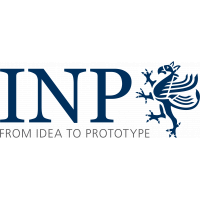Absolute ground state atomic hydrogen densities were measured, by utilisation of two-photon absorption laser induced fluorescence (TALIF), in a low pressure electron cyclotron resonance plasma as a function of nitrogen admixtures - 0 to 5000 ppm. At nitrogen admixtures of 1500 ppm and higher the spectral distribution of the fluorescence changes from a single Gaussian to a double Gaussian distribution; this is due to a separate, nascent, contribution arising from the photolysis of an ammonia molecule. At nitrogen admixtures of 5000 ppm the nascent contribution becomes the dominant contribution at all investigated pressures. Thermal loading experiments were conducted by heating the chamber walls to different temperatures; this showed a decrease in the nascent contributions with increasing temperature. This data set contains the data shown in the corresponding publication in Appl. Phys. Lett. (https://doi.org/10.1063/5.0072534).
| Field | Value |
|---|---|
| Group | |
| Authors | |
| Release Date | 2021-12-07 |
| Identifier | 45f74f4c-22b0-477b-842e-de30f2cbaa82 |
| Permanent Identifier (DOI) | |
| Permanent Identifier (URI) | |
| Is supplementing | |
| Plasma Source Name | |
| Plasma Source Application | |
| Plasma Source Specification | |
| Plasma Source Properties | Electron cyclotron resonance (ECR) coaxial plasma source AURA-WAVE (Sairem): |
| Plasma Medium Name | |
| Plasma Medium Properties | Hydrogen with dilution of nitrogen in the range of 0, 500, 1000, 1500, 2500 and 5000 ppm respectively. Total flow rate of 14 sccm is kept constant. Pressure was varied in the range of 3 – 7 Pa. |
| Plasma Diagnostics Name | |
| Plasma Diagnostics Properties | Two-photon absorption laser induced fluorescence (TALIF) for the detection of hydrogen atoms. For this photons with a wavelength of 205 nm are created through the combination of a frequency doubled Nd:YAG pump laser (Spectra Physics, Quanta Ray), with a pulse width of 6 ns, and with a dye laser (Sirah, Precision Scan SL). The 615 nm red light from the dye laser is frequency doubled with the help of a BBO crystal, and then remixed with residual red light from the dye laser in a second BBO crystal for sum-frequency generation to the required 205 nm radiation. |
| Plasma Diagnostics Procedure | For the detection of the fluorescence a Nikon lens systems was used to image a region of interest of about 10 and 2 mm in the horizontal and vertical distances respectively. As a detector a gateable ccd camera was used (Andor iStar DH734x) in combination with a spectral filter providing a bandwidth of 10 nm centered at around 656 nm for hydrogen and 825 nm for krypton respectively. |
| Language | English |
| License | |
| Public Access Level | Public |
| Contact Name | Lang, Norbert |
| Contact Email |
Data and Resources
- Evidence of the Dominant Production Mechanism of Ammonia (Fig. 2, 0 ppm N2)csv
Gaussian spectral profile for the Hα fluorescence at 656 nm for a pressure of...
Preview Download - Evidence of the Dominant Production Mechanism of Ammonia (Fig. 2, 5000 ppm N2)csv
Gaussian spectral profile for the Hα fluorescence at 656 nm for a pressure of...
Preview Download - Evidence of the Dominant Production Mechanism of Ammonia (Fig. 3, 3 Pa)csv
Plasma and nascent contributions to the atomic hydrogen density as a...
Preview Download - Evidence of the Dominant Production Mechanism of Ammonia (Fig. 3, 5 Pa)csv
Plasma and nascent contributions to the atomic hydrogen density as a...
Preview Download - Evidence of the Dominant Production Mechanism of Ammonia (Fig. 3, 7 Pa)csv
Plasma and nascent contributions to the atomic hydrogen density as a...
Preview Download - Evidence of the Dominant Production Mechanism of Ammonia (Fig. 4, 3 Pa)csv
Fractional contribution, defined as the fraction of the nascent contribution...
Preview Download - Evidence of the Dominant Production Mechanism of Ammonia (Fig. 4, 5 Pa)csv
Fractional contribution, defined as the fraction of the nascent contribution...
Preview Download - Evidence of the Dominant Production Mechanism of Ammonia (Fig. 4, 7 Pa)csv
Fractional contribution, defined as the fraction of the nascent contribution...
Preview Download - Evidence of the Dominant Production Mechanism of Ammonia (Fig. 5, 20 °C)csv
Plasma and nascent contributions as a function of nitrogen admixture for a...
Preview Download - Evidence of the Dominant Production Mechanism of Ammonia (Fig. 5, 60 °C)csv
Plasma and nascent contributions as a function of nitrogen admixture for a...
Preview Download - Evidence of the Dominant Production Mechanism of Ammonia (Fig. 5, 100 °C)csv
Plasma and nascent contributions as a function of nitrogen admixture for a...
Preview Download

![[Open Data]](https://assets.okfn.org/images/ok_buttons/od_80x15_blue.png)